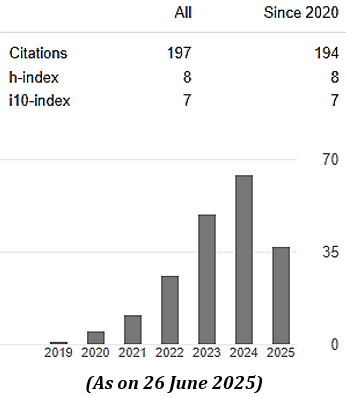Effect of Boric Acid Solubility in Steam on the Process of Mass Transfer during Emergency Cooling of VVER-1200 Nuclear Reactor
Abstract
The mechanisms of boric acid mass transfer in a VVER-1200 reactor core are studied in this work in the event of a major circulatory pipeline rupture and loss of all AC power. The VVER-1200's passive core cooling technology is made up of two levels of hydro accumulators. They use boric acid solution with a concentration of 16 g H3BO3/kg H2O to control the reactivity. Because of the long duration of the accident process, the coolant with high boron content starts boiling and steam with low concentration of boric acid departs the core. So, conditions could arise in the reactor for possible accumulation and subsequent crystallization of boric acid, causing the core heat removal process to deteriorate. Calculations were carried out to estimate the likelihood of H3BO3 build-up and subsequent crystallization in the core of the VVER reactor. According to the calculations, during emergency the boric acid concentration in the reactor core is 0.153 kg/ kg and 0.158 kg/kg in both the events of solubility of steam and without solubility of steam respectively and it does not exceed the solubility limit which is about 0.415 kg/kg at water saturation temperature. No precipitation of boric acid occurs within this time during the whole emergency process. Therefore, findings of the study can be used to verify whether the process of decay heat removal is affected or not.
Downloads
References
Cohen, P. (1973). Water technology of power reactors. Springer Publishing.
Hassan, A. Y., Osturk, S., & Lee, S. (2015). Progress in Nuclear Engineering. Progress in Nuclear Engineering, 85, 239–253.
Hewitt, G. F., & Hall-Taylor, N. S. (1970). Annular Two-phase Flow (136–148). Pergamon Press, N. Y.
Ishii, M., & Grolmes, M. A. (1975). AIChE Journal. Inception Criteria for Droplet Entrainment in Two-Phase Concurrent Film Flow, 21(2), 308–318.
Kalyakin, S. G., Remizov, O. V., Morozov, A. V., YU.S., Y. U. R’. E. V., & YU.V., K. L. I. M. A. N. O. V. A. (2003). Proceedings of Graduate Schools. Nuclear Power Engineering. Substantiation of Design Functions of the Passive Flood System HA-2 for Improved NPP Project with VVER Reactor, 2, 94–101.
Kalyakin, S. G., Sorokin, A. P., Pivovarov, V. A., Pomet’ko, R. S., Selivanov, Y. U. F., Morozov, A. V., & Remizov, O. V. (2014a). Atomic energy. Experimental Studies of the Thermo Physical Processes in Justification of the Safety of the New Generation of VVER, 114(4), 241–246.
Kalyakin, S. G., Sorokin, A. P., Pivovarov, V. A., Pomet’ko, R. S., Selivanov, Y. U., Morozov, A. V., & Remizov, O. V. (2014b). Atomnaya energiya. Experimental Research of Thermal Physical Processes for the Safety Substantiation of New Generation VVER, 116(4), 241–246.
Kopytov, I. I., Kalyakin, S. G., Berkovich, V. M., Morozov, A. V., & Remizov, O. V. (2009a). Experimental investigation of non-condensable gases effect on Novovoronezh NPP-2 steam generator condensation power under the condition of passive safety systems operation. Proceedings of theXYII-th International Conference on Nuclear Engineering, ICONE17. International Conference on Nuclear Engineering, ICONE17, Brussels.
Kopytov, I. I., Kalyakin, S. G., Berkovich, V. M., Morozov, A. V., & Remizov, O. V. (2009b). Proc. 17 Int.Conf. on Nuclear Engineering. 735–743.
Morozov, A., & Sakhipgareev, A. (2017). Experimental estimation of the effect of contact condensation of steam–gas mixture on VVER passive safety systems operation. Nuclear Energy and Technology, 3(2), 98–104. https://doi.org/10.1016/j.nucet.2017.05.002
Morozov, A. V., & Remizov, O. V. (2012a). Teploenergetika. Experimental Justification for Design Functions of Additional Passive Re Flooding Systems of the Reactor VVER Core., 5, 22–27.
Morozov, A. V., & Remizov, O. V. (2012b). Thermal Engineering. Experimental Substantiation of Design Functions of the VVER Auxiliary System of Passive Core Reflooding, 5, 22–27.
Morozov, A. V., & Remizov, O. V. (2012c). Thermal Engineering. Experimental Study of VVER Steam Generator Model Operation in Condensation Mode, 5, 16–21.
Morozov, A. V., & Remizov, O. V. (2012d). Thermal Eng: Vol. 59 (365–370). Springer Publishing. https://doi.org/10.1134/S0040601517050044
Morozov, A. V., Remizov, O. V., & Tsyganok, A. A. (2009). Proceedings of Graduate Schools. Nuclear Power Engineering. Experimental Study of Non-Equilibrium Thermal-Hydraulic Processes in a Passive VVER Core Reflooding System, 4, 115–123.
Newitt, D. M., Dombrowski, N., & Knelman, F. H. (1954). Trans. Inst. Chem. Eng. “Liquid Entrainment: I, The Mechanism of Drop Formation from Gas or Vapor Bubbles, “, 32, 244.
Schmal, I. I., & Ivanov, M. A. (2015a). Boric acid mass transfer processes in accidental conditions. Proc. of the 9th Int. Scientific and Technical Conference «Safety Assurance of VVER NPP». Podolsk, JSC EDO «Gidropress». Published.
Schmal, I. I., & Ivanov, M. A. (2015b). Boric acid mass transfer processes in accidental conditions. 25–29.
Schmal, I. I., & Ivanov, M. A. (2015c). Safety assurance of NPPs with WWER. 25–29.
Vallée, C., Höhne, T., & S. (2008). Two-phase flow phenomena, Experimental Investigation and CFD Simulation of Horizontal Stratified Two-Phase Flow Phenomena, 238(3), 637–646.
MIJST follows the open access policy.

This work is licensed under a Creative Commons Attribution-NonCommercial 4.0 International License. This allows anyone to copy, share, distribute, and modify the work for non-commercial purposes, where the original work and source should be properly credited.
















